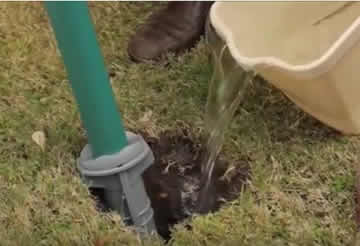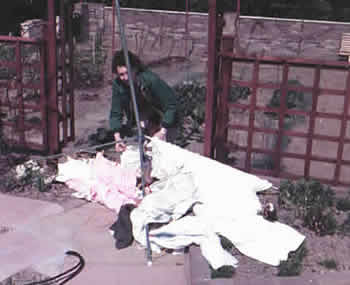How to Install a Rotary Washing Line in your Garden
Setting up a rotary washing line is very simple and can be carried out by anyone with basic handyman skills. It’s important to get a firm foundation in place to get the optimum performance out of a rotary airer.
A portable rotary line which is is only used for basic drying needs can be literally erected in seconds - but these are not the lines of choice for  most people in their gardens.
most people in their gardens.
 most people in their gardens.
most people in their gardens. This type of laundry airer is best-suited when you want to move to different locations in your garden or even indoors. It's also ideal for people who want a device for drying their garments when camping, caravanning or staying in a holiday mobile home.
By far the most popular type of rotary washing line is the three or four arm device which is a permanent fixture in a garden, yard or paved patio area.
There are various sizes and styles available but the principles for erecting them are basically the same in that the metal or aluminium main line pole is inserted into a sturdy ground spike or soil spear which has been fitted in advance.
Most rotary lines will come with a comprehensive assembly guide so take the time to read it carefully before preparing to install your new line.
The method for setting up a rotary line may vary slightly between models but here's a basic guide of the steps which are common to most of them
- Choose a location in your rear garden or yard where a line will be able to rotate easily and freely without the risk of coming into contact with any obstacles.
- Don't position it in a spot which is used frequently for outdoor activities - for example, don't choose a spot used by your children regularly for playing. The line will not take up much space when it's folded down, but it's a completely different scenario when it's erected.
- If you are fitting your rotary airer on a grassed area, ensure it's easily accessible in the winter when the ground may be muddy. Laying a few
 small evenly-spaced paving stones on the grass is a handy solution to avoid getting muddy feet.
small evenly-spaced paving stones on the grass is a handy solution to avoid getting muddy feet.
- If you are erecting your rotary line on grass you can use a soil spear to hold the main pole - the problem with this is that there's a risk the pole will wobble if the ground spear starts to work its way loose when your grass gets wet and the ground below become sodden. If this happens your airer could easily blow over in the wind - and you'll end up in the same predicament as the poor woman pictured!
- It's a much better option to take the time to use a ground spike which is embedded in quick-setting post mix concrete for a much more stable and reliable fitting. Some rotary lines come with a ground spike or socket sleeve as part of the kit, which saves the hassle of buying one separately.
- Carefully remove a small section of turf in one piece from your garden with a spade and put it to one side. Replacing it later will allow you to make a nice job of hiding the solidified concrete mix holding the ground spike in place.
- Dig a hole in the ground to the depth of the ground spike. Most spikes or sleeves will have a sealed end to prevent any concrete mix seeping into them when placed in position. Wrap a bit of plastic tape around the end of any spike that does not have a closed end.
- Position the spike in the centre of the whole you dug in the grass and press it firmly into the ground. Then ensure it is completely vertical - use a spirit level if you don't trust your eyes.
- Mix up some concrete post mix which is a far better and easier option to preparing standard concrete. Next, fill the hole half way with water and then sprinkle the post mix into the hole according to the instructions on the bag. Mix the water and powder combination with a stick or other suitable implement.
- Ensure you leave enough space at the top of the hole to accommodate the section of turf you removed earlier. About an inch of the spike should be protruding above the post mix. Work quickly as post mix dries rapidly.
- Allow the mixture to set and dry and be careful to ensure your spike remains in its original upright vertical position.
- Insert the rotary line into the round access in the spike and ensure it spins freely.
- Finally cut a hole in the centre of the piece of turf you removed earlier to accommodate the ground spike. Place the turf sod over the spike and refit the rotary line.
That's it - follow these guidelines and you will have completed a simple procedure which will provide an excellent strong and stable base for your rotary washing line for years to come.
SHARE THIS PAGE!